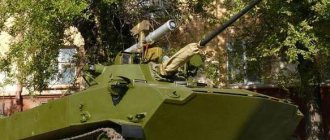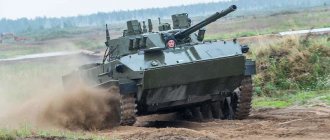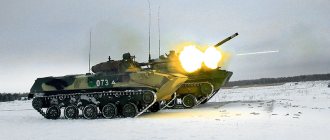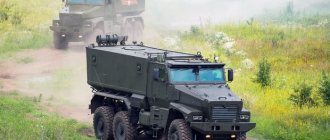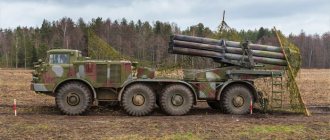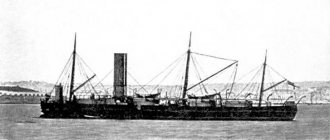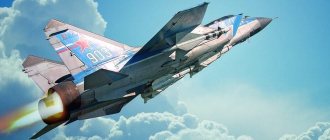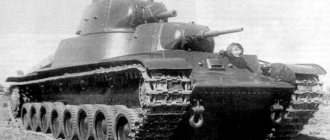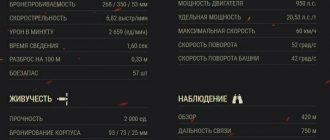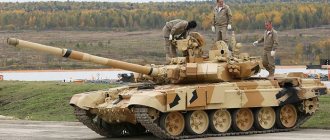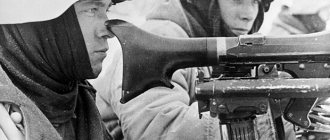BMD-3 TTX, Video, Photo, Speed, Armor
BMD-3 - an airborne combat vehicle was adopted by the Soviet Army in 1990. Its development was carried out at SKB VgTZ to replace the BMD-1 and BMD-2 vehicles. The design of the new vehicle allows it to be dropped together with the combat crew deployed in it by parachute and landing methods from military transport aircraft and by landing method from helicopters. The vehicle has an original chassis and a turret with a weapon system unified with the BMP-2.
Options [edit]
- BMD-3K
is a command version of the BMD-3, adopted by the Russian Army in 1996. Serial production of this machine never began. - 2S25 Sprut-SD (Object 952)
- Self-propelled anti-tank gun, adopted for service in 2005. This vehicle has a BMD-3 chassis and is serviced by a crew of three. The main armament is the 125 mm 2A75 smoothbore gun, which is a variant of the 2A46 smoothbore gun that was used on Soviet main battle tanks starting with the T-64. Can fire 2A46 ammunition, including 9M119 Svir. The chassis has seven road wheels on each side instead of five, and the engine is now 2V-06-2S with a power of 510 hp. [12] - BTR-MD "Rakushka" (Object 955)
is a universal transport vehicle with an enlarged hull and without a turret.
This type can be used to transport troops, fuel, ammunition and casualties. It also serves as the basis for a new line of specialized vehicles for the Russian Airborne Forces, including a mortar platform and an ambulance. BTR-MDM
is an upgraded version with the same improvements as the BMD-4M. [13]
is a chemical reconnaissance vehicle introduced in 2011 and equipped with the same specialized equipment as the BTR-80 version known as RKhM-4. Tower removed; RKhM-5 has a stationary superstructure with a machine gun turret. The hull is larger, allowing it to transport troops, fuel, ammunition and wounded personnel. [2] [14] VDV successfully completed testing of the first three vehicles in March 2012. [15]
Originally designated as
BMD-3M
, this vehicle has a modified chassis with a new turret, known as "Bakhcha-U". The armament is more similar to the BMP-3. This new armament consists of: 100mm 2A70 rifled cannon, 30mm 2A72 autocannon, 7.62mm coaxial machine gun and a new "Ramka" fire control system. The bow AGS-17 was removed and replaced with an AGS-30. BMD-4 are new or upgraded BMD-3. The BMD-4 is no longer purchased for Russian forces in favor of the BMD-4M.
- BMD-4M
- a modernized version with a new chassis and a UTD-29 engine with a power of 500 hp. from BMP-3. This version will be produced at Kurganmashzavod (KTZ) instead of VgTZ. The vehicle was presented to the Airborne Forces in March 2008. According to KTZ, serial production could begin in 2009. BMD-4M passed the examination of the Airborne Forces. [16] In August 2011, the evaluation process was still ongoing and no firm agreement had been reached for the delivery of the first 10 VDVs, as required by the 2011 government order. The Russian Ministry of Defense decided to adopt the BMD-4M into service in December 2012 [17].
is a command and staff vehicle and a repair and recovery vehicle. Some variants will have a longer chassis with seven road wheels and likely the same 510 hp engine as the 2S25.
BMD-3 - video
The bow part of the hull from below is made of three transverse sheets connected to each other, located in the longitudinal section at different angles to the horizon, forming a broken convex outer line, passing from above at an acute angle into a broken concave outer line, made of two sheets located in the longitudinal section under the small and large angles respectively to the horizon. In the fighting compartment, a cannon with a coaxial machine gun is installed in a double turret - the commander and gunner are located to the left and right of the cannon, and it is equipped with a fire control system from the commander's and gunner's workstations, providing commander's target designation.
Firepower of the BMD-3
For observation, the gunner-operator uses three daytime prism devices TNPO-170A and a device with large viewing angles in the vertical and horizontal planes TNPT-1, and when firing a binocular periscope combined sight BPK-2-42. The day system of this device has a field of view of 10 degrees with a magnification factor of at least x6, while for the night system these parameters are 6.6 degrees and 5.5 times, respectively. The commander has, in addition to the already mentioned combined periscope device TKN-3MB, two prism devices TNPO-170A, a periscope device TNPT-1 and a monocular periscope day sight 1PZ-3 with magnifications x1.2 and x4 and field of view angles of 49 and 14 degrees, designed for searching for air targets and aiming a cannon at them (when firing from a standstill), searching for ground targets and aiming a cannon and coaxial machine gun at them when firing from a standstill and on the move.
The cannon and coaxial machine gun are aimed at the target from the control panels of the gunner-operator and commander. The vehicle uses an electromechanical two-plane weapon stabilizer 2E36-4. The minimum stabilized guidance speed (in “automatic” mode) is 0.07 degrees/s, the maximum is 6.0 degrees/s. Transfer speeds in the horizontal plane 30, in the vertical plane 35 degrees/s. The commander's target designation is provided from the button of the TKN-3MB device installed in the commander's cupola. Along with the electromechanical one, there is a manual control drive. When working with a manual drive, a declination angle of 5 degrees and an elevation angle of 75 degrees are provided. When operating in automatic and semi-automatic modes, these angles are 4 and 75 degrees, respectively.
When firing from the AGS-17 course grenade launcher, the grenade launcher uses a PPB-2-2 periscope sight with a field of view of at least 25.5 degrees. For observation, he has a TNPO-170A prism device. To observe and fire from the RPKS-74 machine gun, the machine gunner uses the TNPP-220A periscope device with one and one and a half times magnification and the TNPO-170A prism device.
The airborne combat vehicle is equipped with a fire control system, which uses the same individual fire control panels for the commander and gunner, providing operational comprehensive command target designation and duplicate firing from a cannon and coaxial machine gun, and which has a device for automatically encircling a dangerous zone with a cannon, for example, one installed on the hull a radio antenna machine, containing a limit switch mounted on the machine body, and a copier connected to the tower, the signals from the interaction of which are sent to the gun guidance mechanism;
The vehicle's ammunition capacity has been significantly increased and amounts to 500 rounds and 350 rounds in additional stowage. To combat tanks, there is an installation for firing ATGMs from inside the vehicle. Ammunition - 6 shots.
In the front part of the body of the airborne combat vehicle, a 30 mm caliber forward grenade launcher with a gear mechanism for vertical guidance and with the possibility of horizontal manual guidance is installed in a ball joint connected through the shell to the body of the vehicle, which has a stopper pivotally connected to the body of the vehicle in the non-working position. The grenade launcher has 290 rounds of ammunition.
To combat tanks and other hard targets, the vehicle is equipped with a 9K113(M) guided weapon system. The 9M113 “Konkurs” (or 9M113M “Konkurs-M”) anti-tank missile has a semi-automatic control system. The launcher provides a horizontal guidance angle by rotating the turret (360 degrees), an elevation angle of 15 and a declination of 5 degrees. ATGM firing range is from 75 to 4000 m.
An automatic double-action fire protection system is designed to fight fires. It contains 2 cylinders with fire extinguishing agent (“Freon 114B2”), 4 temperature sensors, control and switching equipment. There are also 2 manual fire extinguishers OU-2. There are 3 smoke grenade launchers of the 902B system installed on the sides of the turret. The smoke grenade launcher is located at the gunner-operator. When 6 smoke grenades are launched, a curtain at least 80 m wide is formed.
BMD-3 protection
To ensure differential armor in thickness, the bow part of the hull from below is made of interconnected three transverse sheets of different thicknesses, located in the longitudinal section at different angles to the horizon ау а2, И, forming a broken convex outer line, passing from above at a sharp angle into a broken concave outer line , made of two sheets of different thicknesses, located in the longitudinal section with angles corresponding to the horizon. The angle was chosen to improve the ricocheting of shots. The angle skhb is set based on the location of the grenade launcher.
Landing and its deployment
The airborne combat vehicle is equipped with seven universal seats connected to the upper part of the hull with a tethering system for airborne landing of the combat crew inside the vehicle, having a working position and a landing position and located in the hull in the control compartment and at the rear near the engine partition of the hull; In the middle of the vehicle is the fighting compartment, which occupies the turret and turret space. At the rear it is limited by a partition behind which the engine and transmission compartment is located. The main armament of the vehicle is installed in the fighting compartment and there are workstations for the commander (to the right of the gun) and the gunner-operator (to the left). Their seats are mounted on the rotating floor of the tower.
Near the engine bulkhead, 3 paratroopers are seated on universal individual seats. Each of them has an embrasure with a ball mount for firing from machine guns (one on the side and one in the roof of the aft hatch. The latter is designed for dismounting shooters and getting them into the vehicle. In total, the vehicle has 7 universal seats: 4 in the front and 3 in the combat compartments. These seats are designed for landing members of the combat crew with the vehicle. In operation, 4 seats are usually used.
Means of communication
The machine uses a transceiver ultra-short wave telephone radio station R-173 with frequency modulation, a simplex and ultra-short wave radio receiver R-173P with frequency modulation, as well as intercom equipment R-174, telephone with electromagnetic laryngophones for 6 subscribers.
Mobility
Possessing a high specific power (32 hp/t), the machine has high mobility. Its average speed on a dry dirt road is 47-49 km/h, the car overcomes a rise of 35 and a roll of 25 degrees, a ditch up to one and a half meters wide, it can enter the water from the shore with a steepness of 30, and exit from the water onto the shore with a steepness of 25 degrees. The vehicle is equipped with a four-stroke multi-fuel diesel engine 2V-06-2 with gas turbine supercharging and intercooling of charge air, with opposed cylinders. Its power ranges from 400 to 450 hp. The air supply system uses a two-stage air cleaner with automatic ejection removal of dust from the dust collector. Its first stage is a cyclone unit, the second stage is oiled cassettes. The engine cooling system is liquid, high-temperature, closed type with forced circulation of coolant and ejection air suction through the radiators. A nozzle heater with fire tube boiler and heat exchanger provides engine preheating in cold weather. Typically, the engine is started using compressed air; an additional starting system is an electric starter.
The machine's transmission consists of a gear and rotation mechanism (GSM), final drives, stopping brakes and control drives. The MPP is hydromechanical with frictional engagement of 2, 3, 4 and 5 gears, with constant mesh gears and a differential rotation mechanism with hydrostatic transmission. It provides 5 forward and reverse gears and continuously variable turning radius control. Stopping brakes are disc, double-acting. Final drives are coaxial, planetary with floating elements. The transmission control drives are electrohydraulic with an electronic automation unit and hydraulic actuators. There is also a manual drive with mechanical and hydraulic actuators.
The caterpillar drive has rear drive wheels and front guide wheels. Drive wheels with removable gear rims, welded guide wheels, with rubber-coated rims. The support rollers (5 per side) are single-pitch, with massive rubber tires; the support rollers (4 per side) are also rubber-coated single-pitch. The vehicle can use two types of tracks - basic (high-speed) and widened (snow and swamp-going). The first - lantern gearing with sequential rubber-metal hinges; the second - with successive open metal hinges and articulated double tracks mounted on elongated fingers. The track width is, respectively, 380 and 600 mm. The track tensioning mechanism is hydraulic with adjustable tension degree.
The car's suspension is individual pneumatic. It consists of 10 air springs that act as hydraulic shock absorbers and power cylinders to change the ground clearance. The minimum vehicle clearance is 130, working – 450, maximum – 530 mm.
Operators[edit]
Map of BMD-3 operators in blue
Current operators[edit]
Angola
- Angolan armed forces - about 10 people, the number in service is unknown as of 2012 [3] [18]
China
- Chinese Airborne Forces - 80 were ordered in 1996 and delivered in 1997[ edit
]
Russia
- Russian Airborne Forces - About 100 BMD-3s in service as of 2012. [19] There are up to 60 BMD-4s in active service, either upgraded from BMD-3s or newly built. [5]
Performance characteristics of BMD-3
— Crew, people: 2 — Landing force, people: 5 — Developer: VgTZ — Years of production: from 1985 to 1997 — Number of produced, pcs.: 143
Weight BMD-3
— 12.9..13.2 tons
Dimensions of BMD-3
— Hull length, mm: 6000 — Length with gun forward, mm: 6360 — Hull width, mm: 3114 — Height, mm: 2170..2450 — Base, mm: 3200 — Track, mm: 2744 — Ground clearance, mm: 130 ..530
BMD-3 armor
— Armor type: bulletproof. Steel turret, aluminum armor hull
Armament BMD-3
— Caliber and brand of gun: 30-mm 2A42 — Type of gun: rifled small-caliber automatic gun Gun ammunition: 500+360 — Firing range, km: up to 4 — Sights: BPK-2-42, 1PZ-3, PZU-5, PPB- 2-2 — Machine guns: 1 x 7.62 mm PKT; 1 x 5.45 mm RPKS-74 - Other weapons: 1 x AGS-17 “Flame”; 1 x PU ATGM 9M111 “Fagot”/9M113 “Konkurs”
BMD-3 engine
— Engine type: 2В-06-2 — Engine power, l. pp.: 450
Speed BMD-3
— Highway speed, km/h: 70..71 — Cross-country speed, km/h: 10 afloat — Highway range, km: 500 — Cross-country range, km: 275..330 — Specific power, l. s./t: 34.1
— Suspension type: independent, individual pneumatic — Specific ground pressure, kg/cm²: 0.32..0.48 — Climbable grade, degrees: 35 — Climbable wall, m: 0.8 — Climbable ditch, m: 1 .5 — Fordability, m: floats
Content
- 1 Development 1.1 Predecessors
- 1.2 Production
- 2.1 Chassis
- 4.1 Current operators
- 5.1 IFVs of comparable role, characteristics and era
Notes
- M. V. Pavlov, I. V. Pavlov.
Domestic armored vehicles 1945-1965. // Equipment and weapons: yesterday, today, tomorrow. - Moscow: Tekhinform, 2012. - No. 5. - P. 21-26. - ↑ 1 2 3 M. V. Pavlov, I. V. Pavlov.
Domestic armored vehicles 1945-1965. // Equipment and weapons: yesterday, today, tomorrow. - Moscow: Tekhinform, 2012. - No. 6. - P. 2-6. - The Military Balance 2016. - P. 195.
- The Military Balance 2016. - P. 429.
See also[edit]
- BMP-3 - Modern infantry fighting vehicle
- BMPT - Tank support combat vehicle
- T-90 - Current main battle tank
BMP of comparable role, characteristics and era[edit]
- CV90: Swedish infantry fighting vehicle
- Dardo IFV: Italian infantry fighting vehicle
- ELVO Kentaurus: Greek infantry fighting vehicle
- MLI-84: Romanian infantry fighting vehicle
- Bradley Fighting Vehicle: US infantry fighting vehicle
- Puma (IFV): German infantry fighting vehicle.
- ZBD-97: Chinese infantry fighting vehicle
- Ratel IFV: South African infantry fighting vehicle
Links
- T-44 · T-54 · T-55 · Object 416
·
Object 141
·
Object 139
·
Object 907
·
Object 140
·
Object 142
·
Object 430
·
Object 435
·
Object 167
· T-62 · T-62A ·
Object 920
· T-64
[/td]Medium tanks Heavy tanks IS-3 IS-4 IS-7 · T-10 ·
Object 266
·
Object 277
·
Object 278
·
Object 279
·
Object 770Missile tanks IT-1 · Item 64992 ·
Object 170
·
Object 431
·
Object 757
·
Object 772
·
Object 282
·
Object 906B
·
Object 775
·
Object 287
·
Object 780Flamethrower tanks OT-54 · Object 483 TO-55
BMPT Object 781 ·
Object 782
·
Object 787
· Object 199 "Frame"* ·
BMPT-72Main battle tanks T-62B · T-64A · T-64BV ·
Object 476
·
Object 172
·
Object 172-2M
· T-72 · T-72A · T-72B · T-72BA · T-72B3 · T-74 ·
T
-80 ·
T- 80A
·
Object 478
·
Object 785
·
Object 187
·
Object 477
·
Object 292
· T-80U · T-80UD · T-90 ·
T-90AM
·
Object 640
·
Object 195
·
T-14 (based on TSUP "Armata")ATGM combat vehicles 2P27 "Bumblebee" · 2P32 "Phalanx" · 9P19 "Eye" · 9P110 "Malyutka" · 9P122 "Malyutka-M" · 9P124 "Phalanga-M" · 9P133 "Malyutka-P" · 9P137 "Flute" · 9P148 "Konkurs" · 9P149 "Sturm-S" · 9P157 "Chrysanthemum-S" · 9P161 "Kornet-S" · 9P162 "Kornet-T"
Combat reconnaissance vehicles BRDM-1 Object 760 (“hover tank”) ·
BRDM-VPK
·
BRDM-VPS
·
Object 8M-906
· BRDM-2 · BRDM-3 · BRM-1K ·
BRM-2
· BRM-3K ·
BKM Airborne Forces "Vydra"
·
Patrol-AFlamethrower combat vehicles BMO-1 · BMO-T Armored personnel carriers K-75 · BTR-40 ·
BTR-112
·
K-78
· BTR-152 ·
ZIS-153
· BTR-50 ·
BTR-E152V
·
ZIL-153
·
GT-L
·
GT-LB
·
Object 1015
· BTR-60 · MT-
D
· BTR-70 · BTR-80 · BMM-80 · BTR-82 · BTR-90
·
BTR-T
· BTR-MD “Rakushka” ·
BMM-D
“ Boomerang " DT
-3PB
"
KrymskArmored vehicles Ural-4320-09-31 Ural-E4320D-31 Ural-E5323D GAZ-39344 ·
"Warrior"
·
"Bear"
·
Ural-6320
· "Typhoon" · ("Typhoon-U" ·
Ural-63099
· "Typhoon-K" ·
KAMAZ-63969
) · "Vodnik" · "Shot" · "Tiger" ·
"Wolf"
·
"Scorpion LTA"
·
"Bulat"
·
"Highlander-K"
·
"Federal-M" ("Stargazer")
·
"Scorpion LSA-B"ASU-76 ·
K-73
· SU-100P ·
SU-100M
· ASU-57 ·
BSU-11-57F
·
Object 574
· ASU-85 · SU-152
"Taran"
·
2S14 "Sting-S"
·
2S15 "Norov"
·
" Hermes"
· 2S25 "Sprut-SD" ·
2S28 "Sprut-K"
[/td]Anti-tank Self-propelled howitzers and mortars SU-152G ·
2A3 "Kondensator-2P"
·
2B1 "Oka"
·
Self-propelled guns with D-80
·
Self-propelled guns with D-80S
·
Self-propelled guns with D-80-2
· 2С1 "Gvozdika" ·
2С2 "Violet"
· 2С3 "Acacia" · 2С4 " Tulip" · 2S5 "Gyacinth-S" · 2S7 "Peony" ·
2S8 "Astra"
· 2S9 "Nona-S" ·
2S11 "Gyacinth-SK"
· 2S12B "Tundzha-Sani"* ·
2S17 "Nona-SV"
·
2S17 -2 "Nona-SV"
·
2S18 "Pat-S"
·
Object 327
· 2S19 "Msta-S" ·
2S21 "Msta-K"
·
2S22 "Flask-3"
·
"Compartment"
· 2S23 "Nona-SVK" · 2S24 "Virgo" ·
2S26 "Pat-K"
·
2S27 "Reef"
·
"Crimping"
·
2S30 "Iset"
· 2S31 "Vena" ·
2S33 "Msta-SM"
· 2S34 "Khosta" ·
2S35 "Coalition-SV"
·
Koalitsiya-SV-KSh
2S36
"Zauralets-D"Coastal A-222 "Bereg" BM MLRS and OTRK TZM 9T451 "Grad-1" · TZM "Grad-VD" · TZM-T “Solntsepek”
SPU SPU 2P2 "Mars" · SPU 2P4 "Filin" · SPU 2P5 "Korshun" · SPU 2P16 "Luna" ZSU-37-2 "Yenisei" ·
Object 130
[/td]37 mm 30 mm 2S6 "Tunguska" · 96K6 "Pantsir-S1" · ZPRK "Roman" ·
ZSU TKB-841 "Pantsir-S1-O"23 mm ZSU-23-4 "Shilka" BM air defense systems and air defense systems Strela-10 BM 9A35 SAM 9K35 "Strela-10-SV" Pine BM SAM "Sosna" Wasp BM 9A33B SAM 9K33 “Osa” Thor BM 9A330 SAM 9K330 “Tor” Cube SURN 1S91 SAM 2K12 "Kub" · SPU 2P25 SAM 2K12 "Kub" · SOU 9A38 SAM 2K12M4 "Kub-M4" Beech KP 9S470 SAM 9K37 "Buk" · SOC 9S18 SAM 9K37 "Buk" · SOU 9A310 SAM 9K37 "Buk" · PZU 9A39 SAM 9K37 "Buk" · RPN 9S36 SAM 9K317 "Buk-M2" Circle SOC 1S12 SAM 2K11 "Krug" · SNR 1S32 SAM 2K11 "Krug" · SPU 2P24 SAM 2K11 "Krug" S-300V KP 9S457 air defense system 9K81 "Antey-300" · radar 9S15 air defense system 9K81 "Antey-300" · radar 9S19 air defense system 9K81 "Antey-300" · MSNR 9С32 air defense system 9K81 "Antey-300" · PU 9А82 air defense system 9K81 "Antey-300" · PU 9A83 ZRS 9K81 "Antey-300" · ROM 9A84 ZRS 9K81 "Antey-300" · ROM 9A85 ZRS 9K81 "Antey-300" Cranes KT-15 · SPK-5 · SPK-12G BIS UR-67 · UR-77 · UR-88 ·
UR-93
· UR-07 · BMR-1 · BMR-2 · BMR-3 · BMR-3MIMR IMR-1 IMR-2 IMR-3 IMR-3M "Klin-1" AZM ·
ADZM "Vostorg-2"
· BAT-M · BAT-2RHM BRDM-2РХБ · РХМ · РХМ-2 · RKhM-3 · РХМ-4 · РХМ-5 · РХМ-6 · РХМ-7
BREM BREM-1 BREM-2 BREM-3 BREM-80U BREM-L BREM-D BREM-K RM-G
MTU MTU · MTU-20 · MTU-55 · MTU-72 · MTU-90 ICC MTP-1 · MTP-2 · MTP-3 · MTP-A5 Other SPU-117 · IRM · IPR · VTS · KDHR-1N · BTZ-3 · LKM-1 · LKM-3 · P-256G · RPM-2 · KhTV-64 · SPM
PRP and PPU PRP-3 "Val" · PRP-4 "Nard" · PRP-4M "Deuterium" · PPRU-1 "Gadfly-M-SV" · 9S482 (PU-12) · 9S482М6 (PU-12М6) · 9S737 "Rank" · 9S737M "Rangir-M" · 15Y56 (MBP) · "Palantin-P" KSAUO 1B13 1B14 1B15 1B16 Object 940 · 1В18 "Klen-1" · 1В19 "Klen-2" · 1В117 · 1В118 · 1В119 "Rheostat" · 1В152 · 1В157 · 1В21 · 1В22 · 1В23 · 1В24 · 1В25 · 1В31
Radar 1RL232 “Leopard” · SNAR-15 "Selenite" · 1RL239 “Lynx” · 1Л219 “Zoo”
electronic warfare 1L21 (SPR-1) 1L29 (SPR-2) 1K11 "Stiletto" ·
“Sanguine”
·
1K17 “Compression”* - produced only for export; italics Promising, experimental, or samples that did not go into mass production were identified

